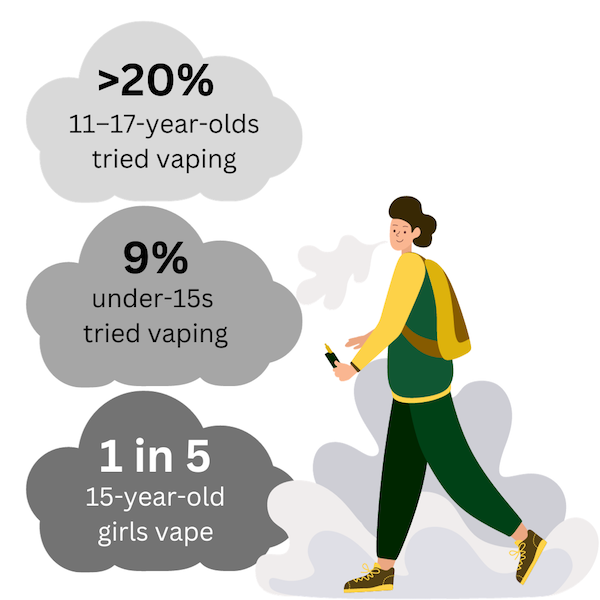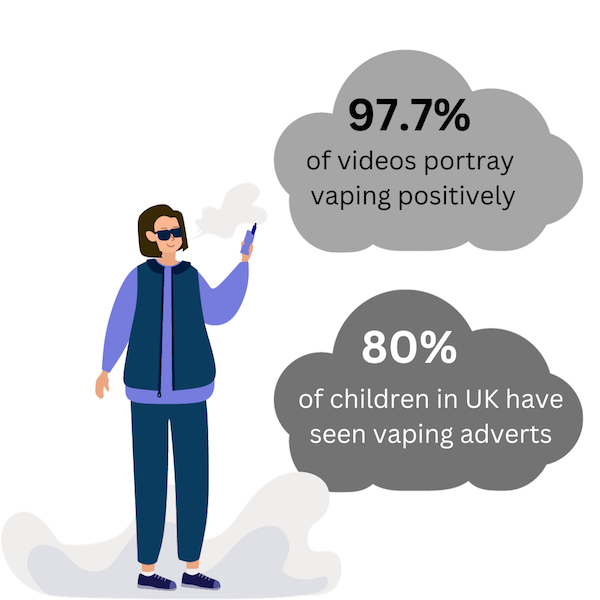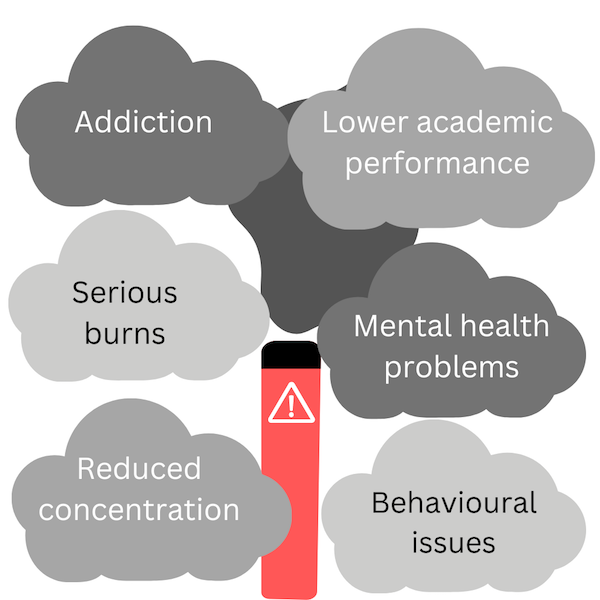Teen vaping has become an unwelcome phenomenon in schools. Luke Ramsden addresses this burgeoning concern, the insidious marketing that permeates young people’s minds and explores how to mitigate the risks of vaping.

Vaping is a growing health concern in schools up and down the country. With more than 20 per cent of children between 11–17 having tried vaping (ASH) and 9 per cent before the age of 15 (NHS Digital Health Survey for England, 2021) – a higher proportion of girls than boys (Guardian, 2022) – what measures can we put in place to reduce vaping and how can we, as teachers, do more to discourage vaping within our schools?

Part of the reason for the rise in vaping is its extremely effective marketing, designed specifically to be attractive to young people. Vapes are brightly coloured, given interesting flavours, disposable and readily available. What’s not to love for a teenager, vulnerable to the pressures of peers, marketing and social media? The devices trend on many social media sites such as TikTok, with one study finding that 97.7 per cent of videos about vaping portrayed it positively (Curtin University, Australia, 2023).
While advertising cigarettes was banned in the UK in 1965, around 80 per cent of children in the UK have seen adverts for vaping within the past year (ASH, 2023). A quick look on Amazon reveals just how many kinds of vapes are available.

Most worryingly, many vapes are practically indistinguishable from common stationery items such as pens, USB drives and highlighters, with experts warning that children may be hiding vapes in plain sight (CBS News, 2023). It is also striking how advertisers depict vapes alongside images of fruit and other typically healthy foods; it is as if vapes are marketed as a ‘health food’. Indeed, vapes are also prevalent in the diet and eating disorder culture, with nicotine abused to deliberately suppress the appetite.
To make matters worse, illegal vapes are often sold to children, with some shops selling vapes that contain 12,000 puffs of e-liquid, while by law, it is restricted to 600.
In the north-east of England alone, more than 1.4 tonnes of illegal vapes were seized from shops across half a year (BBC, 2023). Children are ill-equipped to distinguish between these harmful illegal vapes, which contain far more nicotine than legal vapes, which have a 2ml tank size and a maximum nicotine strength of 2mg/ml. It is vitally important that both children and adults are aware of these crucial differences between legal and illegal vapes.
While being advertised as a healthier alternative to smoking, illegal vapes have been found to contain dangerous chemicals such as THC, lead and formaldehyde.
More generally, the health risks associated with vaping include addiction and even serious burns caused by vapes exploding (Cleveland Clinic, 2022). The long-term effects of vaping are still unknown, but teenagers’ developing brains are particularly vulnerable to the effects of drugs. Studies have already shown that, in the short term, vaping can lead to reduced concentration, behavioural problems and lowered academic performance (PubMed, 2021), as well as being associated with mental health risks such as depression and anxiety (Forbes, 2023).

All this begs the question: how are we, as teachers, to reduce the impact of vaping among our students? Here it is useful to look at young people’s motivations for vaping. Surprisingly, most young people seem to be aware of the health risks of vaping. A survey by ASH (2023) showed that most young people believed vaping was as or more harmful than smoking. In fact, the most common reasons are simply to give it a try because other people are vaping and among those who already vape because they like the flavours. The FDA in America reported in June 2021 that 97 per cent of youth users had used a flavoured e-cigarette in the past month (Truth Initiative, 2021). This is particularly striking, as it suggests that even though children appear to be aware that there are serious risks associated with vaping, this is not enough to dissuade them.
Of course, we can ban e-cigarettes from our classrooms, imposing strict sanctions on those caught vaping on school grounds; indeed, this is already widely done in schools. In addition, sensors such as HALO can detect vaping in areas such as school bathrooms. However, the fact is we cannot control our students’ vaping outside school. Education is the key tool, both for teachers and students. While students are aware that vaping has health risks, they are probably not aware of the extent of these. There are excellent resources for schools about this. In 2022, the government provided information on vaping on the FRANK and Better Health websites, and there are many more educational resources out there, such as those of the PSHE association (Healthmedia, 2023).
In addition, we should make students aware of the misleading nature of advertising around vapes, particularly in the extent to which they are portrayed as a part of a healthy lifestyle. While it is understandable that the NHS advertises vapes as safer than cigarettes, they are not safer than not vaping or smoking at all! Education on the considerable negative effects of peer pressure, both from their own peers and from social media, is also very important as part of school PSHE programmes. Parental collaboration and education are also incredibly important in discouraging vaping.
Many parents are unaware of the immense health risks associated with vaping. Parents are particularly important in the battle against teen vaping, given that they generally control the purse strings that allow young people to buy these vapes!
Of course, alongside bans on vaping and delivering vaping-specific education, we need to provide resources, support and understanding for students who are already vaping. Given the high nicotine content of many vapes, many young people are developing genuine addictions to vaping. We should not punish students for wishing to give up vaping. It is important that if young people seek help from school in giving up vaping, they receive support in this rather than purely facing disciplinary sanctions.
Undoubtedly, vaping is a potential crisis for our young people, with the government still dragging its feet on meaningful legislation. However, with wider education on the considerable health risks of vapes and a combination of disciplinary and supportive measures for our young people in schools, we can mitigate the risks of vapes.
 Pupil Wellbeing Award
Pupil Wellbeing AwardSupport and improve physical, emotional and mental health for all pupils.